On September 8th, 1923, seven American destroyers ran aground at Honda Point, on the coast of California. It was a foggy night, and the crew of the lead destroyer, Delphy, had gotten confused and thought they were further south than they actually were before turning for the Santa Barbara Channel. And a number of the following destroyers, in line at high speed, followed her onto the rocks. Their crews responded magnificently, and the men from four of the ships - Delphy, S. P. Lee, Young and Chauncey - had managed to get ashore, while a fifth, Nicholas, was in a position where the crew couldn't reach shore safely, and would have to wait out the night. The men who had made it ashore got help from the nearby railroad Section House, and aid was summoned from nearby towns.
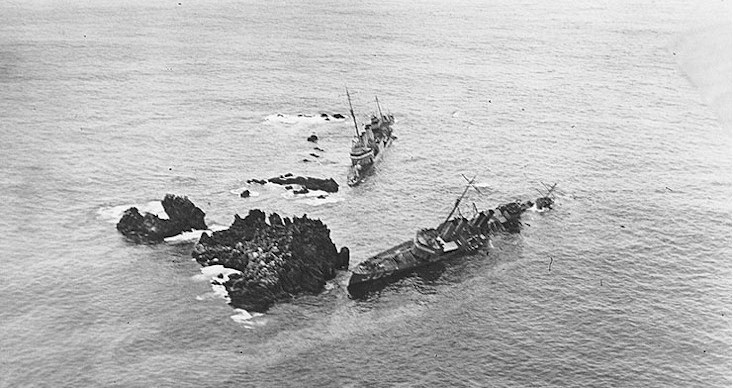
Woodbury and Fuller aground
Unbeknownst to them, two more ships, Woodbury and Fuller, had struck rocks 300 yards offshore, although fortunately the rock that Woodbury had struck was about 25' high and big enough to shelter the crew until help could arrive. A few men had jumped across to it when the ship first struck, although unsuccessful attempts to back Woodbury off had widened the gap somewhat. A line was quickly passed, and the crew evacuated hand-over-hand despite the attempts of the ship's roll to snap the ropes. A survivor from Young was discovered in the water alongside and fished out, while the Captain had the presence of mind to order food, water and fuel be transferred to the rock, allowing the crew to stay in reasonable comfort. Another stroke of fortune was the presence of DesDiv 33's medical officer aboard Woodbury, although he had few patients to deal with.
Fuller had grounded further out from the rock, leaving her crew no easy way to get to safety. The obvious answer was to pass a line to Woodbury and use her as a bridge, and to do so, Fuller's crew lowered their whaleboat, but a mishap in the process smashed the steering oar and left the volunteer crew with poor control as they tried to pick their way through a ring of rock around the stricken destroyer. Somehow, they fought through, but the seas were too rough for them to get the line and the men in the whaleboat pulled offshore to wait for dawn, leaving those still aboard Fuller with no idea what had happened to them. An attempt to take a line to Woodbury using a raft failed, and the crew remained onboard until dawn, despite the ship settling beneath them. With daylight came sight of the whaleboat, which was finally able to come alongside and take a line to Woodbury, although the threat of the abandoned destroyer sliding into deeper water meant that the line was passed to the men on the rock. This effort failed, leaving the men aboard Fuller stranded until the Captain swam to the rock, followed by another man towing a line. The boat crew met them and helped the evacuation onto the rock, where they joined the men of the Woodbury around their fire.
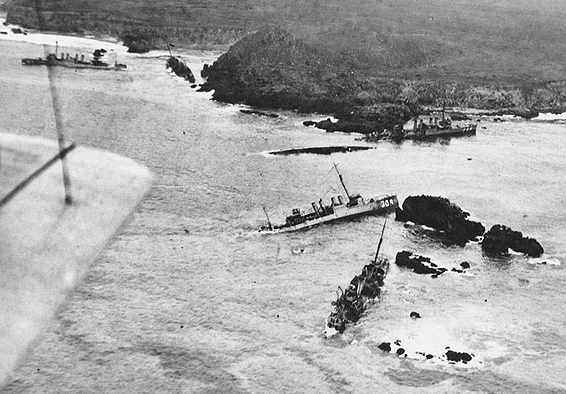
Ashore, there was not even knowledge of the plight of the crews of Woodbury and Fuller, and efforts continued to provide aid to the survivors on the mesa. Word came in that five men swept off the Young had been picked up by the keepers at Point Arguello Light nearby, while food, blankets and the wife of one of the railroad men arrived on the 2AM freight train from San Luis Obispo. This was a tremendous relief to the men huddled by the fires along the tracks, and more supplies came in two hours later on another southbound train, which also took 13 of the most badly wounded men to the hospital in Santa Barbara. Food and coffee were passed out, although the distribution of the latter was greatly hindered by a shortage of mugs.
Dawn brought a breeze that slowly dispersed the fog that had shrouded Honda throughout the night, revealing the scale of the disaster, but also opening the way for the crew of the Nicholas to be rescued. Her men had spent the night onboard, exposed to the pounding of the waves, but the ship had held together and the crew was even in reasonably good spirits as rescue efforts got underway. A party boarded the Lee and attempted to fire a line to Nicholas with a line-throwing gun, but the wind kept carrying it away. A local offered to swim out to the stricken destroyer with a line of his own, but the waves defeated him and the crew aboard Lee eventually managed to land the messenger on the Nicholas, and a ferry was rigged to take the crew ashore using a raft hauled by a group of men ashore. Despite the heavy surf, all of the men aboard Nicholas reached shore safely (although they were usually doused in oil) and were quickly taken up the mesa where fires and food waited. Some of this food was from the trains, but the bulk was salvaged from Chauncey and Lee, which also provided cooking implements and a solution to the mug shortage.
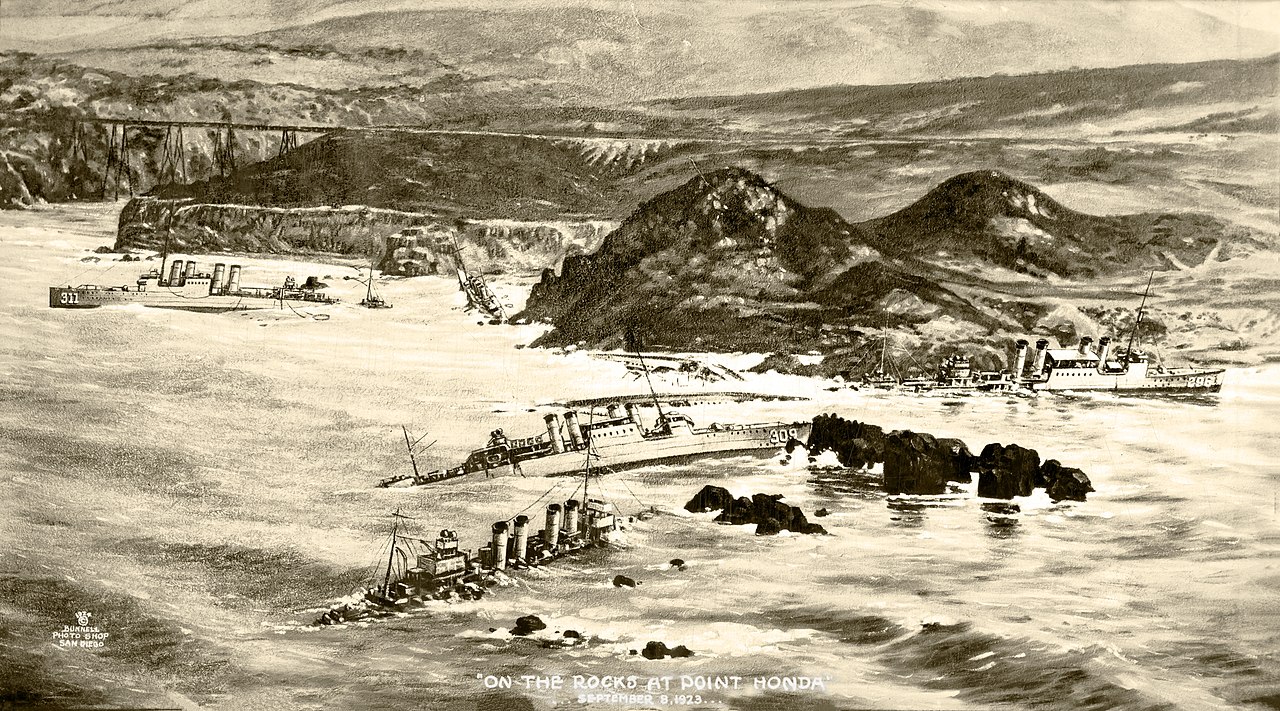
The lifting fog also revealed Woodbury and Fuller to the men ashore, who were finally aware of the full extent of the disaster. But there was little they could do to help the men on the rock. The initial plan was to evacuate using the boat from Fuller, but this would be a long and hazardous process, and after the first two boatloads of men were landed on the beach near Chauncey, another option appeared out of the fog. It was Roma, a fishing boat out of Santa Barbara, which quickly sent out its skiff to pluck the crews off the rock, ferrying them to Somers and Percival, still waiting offshore. Now that they could see, the destroyers also contributed their whaleboats, and with the task done, Roma went on her way and the destroyers headed for San Diego.
With all of the crew safe, all that was left was to clean up the mess. The survivors on Honda Mesa were picked up by a train from San Diego that afternoon and taken down to San Diego, where their families waited for them. They were greeted along the way by the residents of various towns, who were quick to donate clothing and refreshment. A small detachment of 2 officers and 16 men were left behind to guard the wrecks from looters, recover any bodies that washed up and begin salvage operations. Ships gathered offshore were supposed to land supplies, but heavy surf meant that they spent several cold, hungry days on the mesa. The problem was compounded when the wrecks became an instant tourist attraction, drawing thousands to gawk and hunt for souvenirs. But eventually the crews were joined by salvage personnel, and work began on recovering what equipment they could, including confidential documents, deck guns and torpedoes. Hopes of refloating Chauncey were quickly dashed, and eventually the work was done. The tourists went home, the sailors left, and the ships were sold to a civilian scrapper. It's not quite clear what happened afterwards, but much of the wreckage was left to slowly decay in the surf.
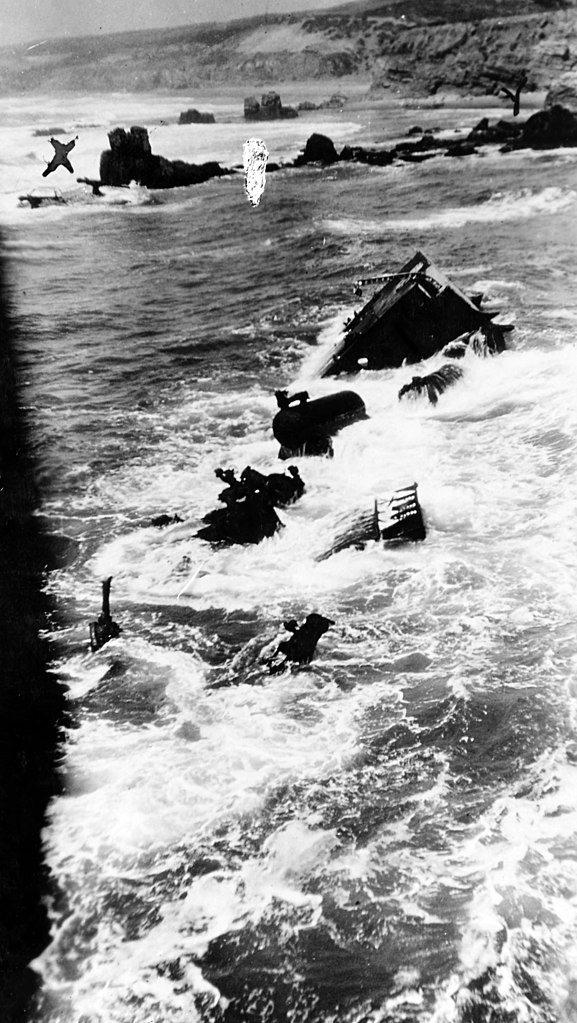
The wreck of S.P. Lee, with the remains of Nicholas in the background, late 1924
But that still left the issue of allocating blame. While the media was initially quick to remind readers that naval operations were inherently hazardous, the secrecy in which the initial court of inquiry was conducted quickly set off rumors of a cover-up, including claims that the bridge crews had been drinking (a live issue during Prohibition). The Secretary of the Navy decided to quell them by holding the inquiry in public, with the captains of the ships and senior officers of the squadron on formal trial. The result was a media circus, focusing mostly on the validity of the bearings received from the new radio compass at Point Arguello, which would use direction-finding gear to respond to requests for bearings. Delphy had requested bearings (the exact number is unclear) and her officers claimed that the bearings had placed them southeast of Point Arguello instead of northwest, which aligned with their dead reckoning. The station claimed that they had initially sent the northwest bearings, but had also sent the reciprocal1 at Delphy's request. Much of the inquiry involved dueling testimony about the reliability of radio bearings and appropriate navigation precautions to take in the area. After a few days, Captain Edward Watson, commander of Destroyer Division 11 and the man in overall command on that terrible night, took the stand and assumed full responsibility for the disaster, hoping to shield his subordinates from professional consequences even at the ruin of his own career.
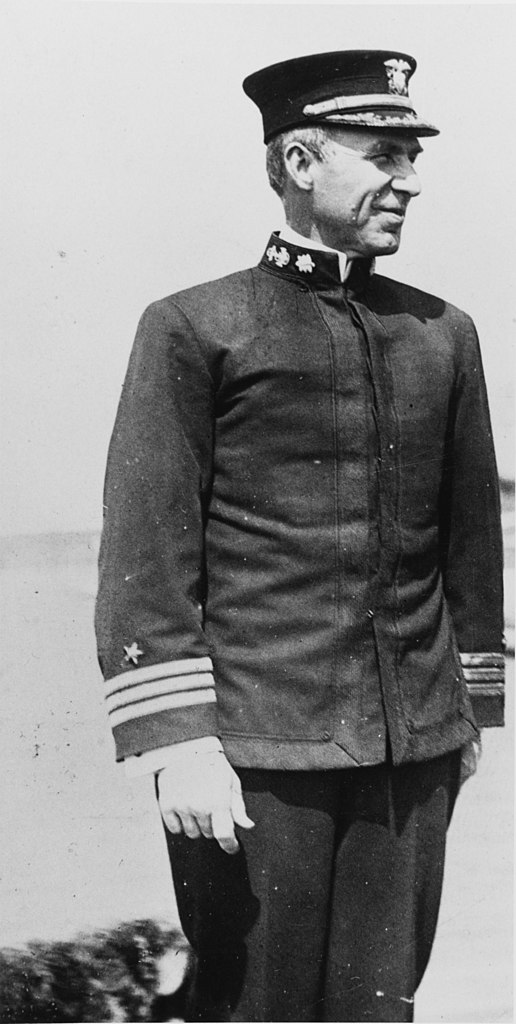
Edward Watson
In this, he was unsuccessful, and a general court-martial was called for Watson, the captains of all seven grounded destroyers, Delphy's navigator and the COs of the two destroyer divisions. Ultimately, Watson and the captains of Delphy and (weirdly) Nicholas were found guilty while the others were acquitted. Watson and Lt. Cmdr. Donald Hunter of Delphy were each reduced on the promotion list, ensuring that their careers would end at their present ranks, although both served until 1929. But the fact that most of the participants were let off didn't sit well with Washington, which wanted more scalps, and the Secretary of the Navy disapproved all of the other verdicts, leaving those officers in a weird legal limbo, although it didn't stop several from distinguished careers, most notably William Calhoun of the Young, who went on to command the Service Force for the Pacific Fleet during WWII and retired as a full Admiral, and William Pye, commander of DesDiv 31, who was commander of the Battle Force in December 1941 and took over for Kimmel at Pacflt before Nimitz arrived in Hawaii, retiring as a Vice Admiral.
Surprisingly, the disaster, costly as it was, had essentially no effect on the USN's operational strength. 267 destroyers of the Wickes and Clemson classes had been built as a result of the wartime destroyer program, far too many for the USN to keep active in peacetime. As a result, destroyer strength in 1923 was only 103, and the seven vessels lost at Honda were replaced by seven taken out of reserve, the crews transferred essentially intact to the new ships.
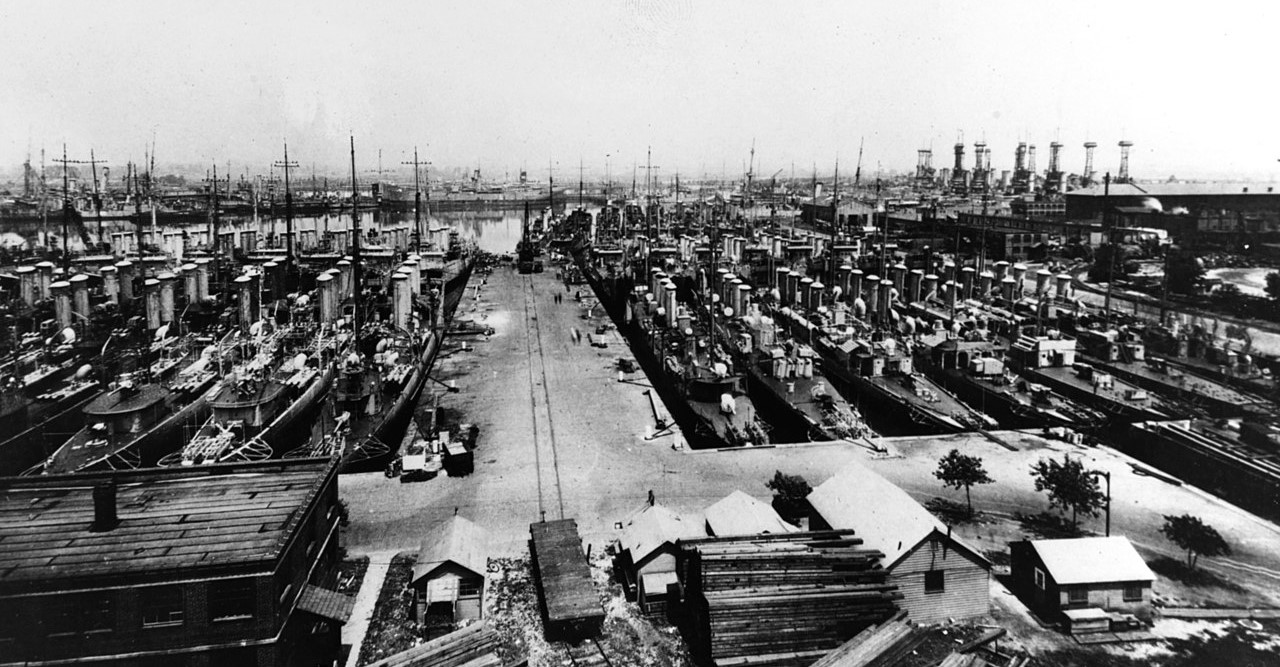
Mothballed destroyers, 1923
But what actually caused the disaster? There was talk of currents stirred up by the great Japanese earthquake of the previous week that pushed the ships northward, but evidence from the court-martial does not appear to bear that out. Instead, the problem appears to be that speed was measured by the use of propeller RPM, a method that is not particularly accurate in rough weather, and the men aboard Delphy became fixated on where they thought they were and ignored the conflicting information from the radio bearings, which in fairness were a new technology at the time. And where they went, so did the rest of the ships in the squadron.
Honda Point remains the greatest loss of ships in a peacetime disaster in the history of the US Navy. Given its scale, it is astonishing that only 23 men died, three during the evacuation of Delphy and 20 from Young's sudden capsize. And the crews at every level performed magnificently, in the finest traditions of the US Navy. Even in the face of unexpected disaster, they did their best to save their ships, and each other. And while accidents will continue to occur for as long as man sails the seas, we can hope that the US Navy will never experience such a disaster again.
1 Many direction-finding systems don't generate an unambiguous bearing, and instead show both the actual bearing and the bearing 180° away. This is usually fine because it's obvious which is correct, but it wasn't in this case. ⇑

Comments
That radio navigation method implies that at least one of the ships had a radio transmitter, but you don't mention anyone using it to ask for help. Was it only Delphy that had one, and lost power too quickly to use it after grounding?? Or was this not a situation where outside help would be very useful, given the time it would take to arrive and the difficulty of finding the wrecks in the fog?? The coast guard (i.e. sea rescue service, among other things) existed then, but don't appear even after the first crews get ashore and gain the ability to communicate.
No, all of them had radio, but the only signal I believe anyone got off was a "turn 90 to port" from Delphy, which was not particularly helpful and rather too late. Destroyer doctrine was big on "follow the leader" and power was lost pretty quickly on all of the ships. The ones still offshore were pretty confused about what was going on, although I don't think I saw a good explanation of why they didn't at least raise an alert.
There was actually a battery-operated set on one of the ships (maybe Chauncey) that was put in action sometime on the morning of the 9th to communicate with Adm. Kittle as he approached. I suspect everyone was too busy trying to get to safety to think about it earlier.
Thank you for your 3-part series on the Honda Point disaster. I was aware of it but not in such detail. Does your source, “Tragedy at Honda,” answer this question: why did they choose this course plan for the SF to SD transit? To this layman, trusting to dead-reckoning to navigate two night-time course changes in confined waters* when they could have bypassed the Santa Barbara channel altogether at the cost of only an hour or so delayed arrival in SD, seems foolhardy—unless they’d done it before. Was this transit a ‘first,’ or one that DDs had been making since the days of the Great White Fleet?
*the second being at the eastern end of the channel, 5 hours further on at 20 knots.
It certainly gave the impression that this was a normal route. If it had been a novelty, I'm pretty sure that it would have been mentioned during the various legal proceedings, and it wasn't.
Seems reasonable, thanks.